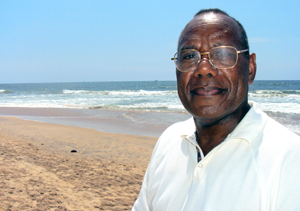ABM Archive Website
THIS WEBSITE CONTAINS ARCHIVE MATERIALS FOR HISTORICAL REFERENCE ONLY
For up-to-date information, including our latest appeals, news, and resources, please visit our current website.
Pastors and Disasters
 |
| Jasper Bonie from the Anglican Church of Melanesia Climate Change program in the Solomon Islands was a participant at the meeting. |
Our television screens regularly bring us graphic images of the destruction and human misery caused by natural disasters. We, the audience, are deeply moved, and dig deep into our pockets to send money to organisations that we hope will be able to help the afflicted and rebuild lives.
But what if the worst impacts of such disasters could be avoided? What if people could be better prepared and thus better able to protect themselves and their communities from much of the destruction that natural disasters usually bring?
This is the philosophy behind the concept of Disaster Risk Reduction. And this is the reason for a meeting in Sri Lanka this month of a team of disaster relief and development workers from all over the Anglican Communion. ABM was represented, as well as our partners from the Solomon Islands, Myanmar, China and South Sudan, and representatives of Anglican churches in El Salvador, Brazil, Burundi and Sri Lanka.
The meeting was the second in a series of meetings focussed on the production of a Disaster Risk Reduction and Preparedness Toolkit (tentatively named Pastors in Disasters), for use by Anglican churches and the communities in which they live around the developing world.
The writing of the toolkit was the brainchild of Episcopal Relief and Development, the development arm of the Episcopal Church in the United States (who are also funding most of the project). The idea came about after their experience working with the Episcopal (Anglican) Church in Haiti after the catastrophic January 2009 earthquake there. It was felt that existing disaster preparedness tools did not provide enough detail to be an effective training manual for churches who are often the first to respond to disasters in their areas.
Churches often have a deep reach into rural areas where many natural disasters hit. So it makes sense to equip them with tools to prepare for and minimise the risk of injury, loss of life and damage to property and the landscape during disasters.
The first meeting of this international Anglican group outlined the minimum international standards of disaster risk reduction and response that the Toolkit needs to meet. During the year, people worked in small teams to produce almost 70 practical tools to help churches to meet these standards.
 |
| San Lin from the Church in the Province of Myanmar role plays a disaster risk mapping exercise for use with communities. |
At the Sri Lanka meeting, participants spent a week testing out the 70 odd tools, or protocols, for preparing for, responding to and learning lessons from disasters. These tools include how to analyse both the vulnerability and the capacity of communities to respond to disasters; how to ensure most obvious risks are mitigated; how churches can mobilise their communities; how churches can work with other faith groups, with government, the military, the UN, NGOs etc when planning for disaster response; and what are the particular strengths of churches in providing disaster preparedness and response. Does the church building need to be reinforced to ensure it survives a flood, and can it be used to house victims? How can the church form a committee to take responsibility for leading the disaster preparedness program? Do toilets and fresh water sources need to be built above the flood-line to ensure people can access clean water and sanitation during an emergency? Do the clergy need special training to provide trauma counselling during an emergency? How can the community be motivated to plant trees on the slopes and embankments to reduce the risk of landslides and slow down water run-off during storms?
The next steps will be to test out the tools in the field, to ensure they are practical and will work. Once they are all approved, the Toolkit will be translated into many languages, to enable it to be used by Anglican churches (and other similar groups) all over the developing world.
The participants at the Sri Lanka meeting all agreed that the meeting was a great success. Some have already begun to use the tools, and have found them to be invaluable. All look forward to continuing to work on this important project which we know will help to save lives during disasters.
Dr Julianne Stewart
October 2012
< Back


